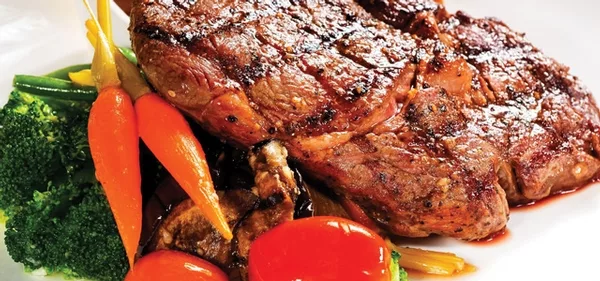Building a Solid Foundation in Meat Processing and Preparation

The State University College of Agriculture and Technology in Cobleskill, NY (SUNY Cobleskill) offers curricula in every facet of food production, giving students the opportunity to not only see but also experience the full cycle of food production from “farm to table.”
The most important part of the SUNY Cobleskill student’s education is related to the safe processing and handling of food. Food safety overshadows all other quality factors. If the food is not safe to consume, it does not matter if the meat is tender, organic, dry aged, fresh, frozen or packed in gold foil! Over 76 million U.S. consumers become sick each year from foodborne illness. Over 300,000 of these individuals are hospitalized and 5,000 people die because of this illness.[1] To emphasize the importance of food safety, four basic food safety principles are incorporated into the SUNY Cobleskill curriculum.
Principle 1: Providing meat to the consumer is no longer the responsibility of one individual or farm.
Today’s food production is a complex and interrelated system. From the grasses and forages animals are fed, to the packaging used for the processed meat, each part of the system must be held to high standards to avoid the contamination of meat with any biological, physical or chemical hazard. Some of the built-in safeguards in the meat industry include random testing for antibiotics by the U.S. Department of Agriculture (USDA) Food Safety Inspection Service at the slaughterhouses and the mandatory inspection of meat by USDA. New monitoring and tracking systems for animals through computer chip identification and purchasing seeds and feeds from USDA-approved sources provide additional protections for the farmer and consumer.
The Food Safety Modernization Act (FSMA) signed into law in 2011 “aims to ensure the U.S. food supply is safe by shifting the focus from responding to contamination to preventing it.”[2] Food safety concerns have increased with the globalization of the food supply. Often, outbreaks of foodborne illness are tracked back to ingredients grown in countries where there are fewer controls, lower standards of quality and less monitoring.[3] International efforts to set standards for food safety are ongoing.
Principle 2: Microorganisms are ubiquitous and compete with us for their survival.
Many bacteria require conditions around the body temperature of mammals to reproduce. For the meat industry, this means that as soon as an animal is harvested, the conditions are perfect for bacteria to reproduce in the meat. For this reason, food processors begin reducing the temperature of the carcass to below 41 °F or colder as fast as possible. In the beef industry, special attention must be paid to Escherichia coli O157:H7 and its relatives. These organisms can infect the intestines of humans if contaminated meat is consumed. The organism produces a toxin that causes bloody diarrhea, and in young children and the elderly, these infections can result in multiple organ failure. Some microorganisms are not pathogenic but cause food spoilage. These spoilage organisms cause economic losses throughout the food chain.
Principle 3: There is no substitute for cleaning, whether we are talking about a pasture, barn, food processing area or home or commercial kitchen.
In addition to cleaning, sanitizing food contact surfaces and equipment is essential. Cleaning is defined as the removal of soil or dirt from an area or surface. Sanitizing is the reduction of microorganisms to very low levels. Routine cleaning around all farm and food production areas should be planned, scheduled and checked. Researchers are concerned with the potential residue that builds up in the crevices on the surfaces where the meat and food are prepared. There is interest in finding new sanitizers and methods for keeping the work surfaces impermeable so that they are easier to keep both clean and sanitized. Research efforts using nanotechnology to find solutions for cleaning and sanitizing problems on meat processing lines are ongoing.[4]
Principle 4: Consumers need to be educated regarding their responsibility for safe food.
Many bacteria are destroyed by heating. For this reason, consumers need to know that the beef they purchase should be cooked properly before it is served. For most beef, this means bringing the roast or steak to 145 °F and measuring the final internal temperature with a thermometer. Ground beef needs to be heat-treated to 160 °F to be sure that it’s safe to eat. Eating undercooked beef is dangerous, so labeling the temperature for the final internal cooking temperature of all meat is important.
Moreover, consumers must be given directions regarding the shelf life of fresh meat. Beef should be refrigerated as soon as possible after purchase. Fresh meat can be held in the refrigerator for 3–5 days at 41 °F or below. Ground beef can be left at refrigerated temperatures for 1–2 days. If meat is not to be cooked and prepared before this time frame, consumers must know to freeze the meat. Although it is safe to freeze meat in the containers in which it was purchased, for long-term freezing, USDA recommends the use of freezer paper or aluminum foil or freezer-grade plastic. Lastly, providing consumers with safe thawing methods for frozen meats is important. The best way to thaw meat is in the refrigerator, which allows the ice in the meat to melt but prevents the meat from exceeding 41 °F and entering the danger zone for bacterial growth.
Food production and preparation courses focus on these four food safety principles, promoting meat safety from farm to table. In all parts of the student’s education, a hands-on approach is taken in the instruction of food handling, preparation and safety.
The campus meat processing laboratory operates under USDA inspection. Students witness a Hazard Analysis and Critical Control Points approach to meat processing and learn the importance of following Sanitation Standard Operating Procedures and Good Manufacturing Practices. They also learn the required record keeping that documents that critical limits are not exceeded, keeping product safe for commerce.
SUNY Cobleskill has also started a Meat Processing and Food Safety certificate program. This intensive 1-month training is designed to give participants a solid foundation in meat animal harvesting, carcass breakdown and processing, food safety and customer relations. Graduates of this certificate program find employment in groceries, small processing plants, farmers markets, opening their own small plants and working in the culinary industry.
In the culinary arts program, students are required to pass the National Restaurant Association’s food safety course and exam. The curriculum for this course covers the basic concepts of food microbiology and the safe way to prepare food and clean and sanitize facilities used in food preparation.


Eric Shelley is the meat processing laboratory manager at SUNY Cobleskill.
3. Onwulata, L., F. Flora and W. Kramer. 2008. Global opportunities in Agri-food science and technology. Food Technology 62:41–47.
4. Goddard, J. 2011. Improving the sanitation of food processing surfaces. Food Technology 65:40–46.
Looking for quick answers on food safety topics?
Try Ask FSM, our new smart AI search tool.
Ask FSM →








